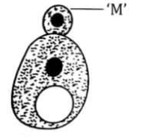Draw the diagram of oblique binary fission process.
Important Questions on Reproductive System
Identify the asexual reproductive structure in the following diagram:

(i) During favourable conditions Paramecium stops feeding after attaining its maximum growth.
(ii) At first the micronucleus divides by amitosis and the macronucleus divides into two daughter nuclei by mitosis.
(iii) The proter receives the anterior contractile vacuole, cytopharynx and cytostome from its parent individuals.
(iv) Before karyokinesis a transverse constriction appears in the middle of the body.
Statement I: The binary fission of Euglena is called homothetogenic fission because the daughter euglenae are like mirror images.
Statement II: Binary fission in Paramecium is known as perkinetal fission because it occurs at right angles to the kineties.
Match the following
| List-I | List-II | ||
| (A) | Longitudinal binary fission | (I) | Paramoecium |
| (B) | Transverse binary fission | (II) | Amoeba |
| (C) | Sporogony | (III) | Pleurobrachia |
| (D) | Sporulation | (IV) | Plasmodium |
| (V) | Euglena |
| Column I | Column II |
| A. Binary fission | 1. Algae |
| B. Zoospore | 2. Amoeba |
| C. Conidium | 3. Hydra |
| D. Budding | 4. Penicillium |
| E. Gemmules | 5. Sponge |
i. Some eukaryotes
ii. All eukaryotes
iii. Some prokaryotes
iv. All prokaryotes
Represent the union of two sets by Venn diagram for each of the following.
is a prime number between and
is an odd number between and
Read the following statements and choose the correct option:
Statement I: During unfavourable conditions, the Amoeba develops a single-layered cyst wall.
Statement II: Encysted Amoeba divides through binary fission during unfavourable conditions.
| I | II | ||
|---|---|---|---|
| (a) | Planaria | (i) | Binary fission |
| (b) | Fungi | (ii) | Asexual spores |
| (c) | Yeast | (iii) | Budding |
| (d) | Amoeba | (iv) | True regeneration |
| (v) | Fragmentation |
Explain with examples types of asexual reproduction in unicellular organism.

